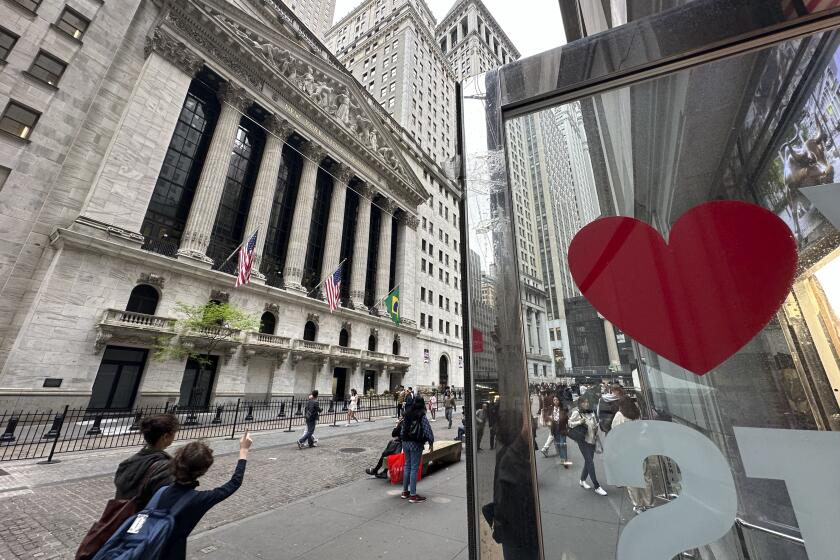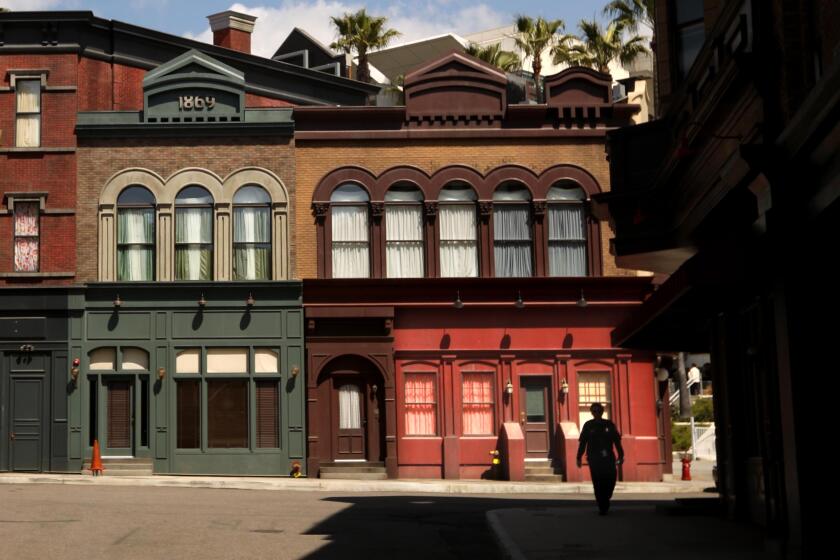Melrose Merchant Razes His House in Manuever for Parking Space
Nobody believed Richard Jebejian would actually tear down his house on Vista Street.
Even Jebejian himself seems stunned by it now, five weeks after wreckers leveled the decrepit house on the far side of an alley that runs behind his strip of funky and fashionable shops on Melrose Avenue.
But the stakes are high in the Melrose area, where merchants are struggling with homeowners in a war of attrition over parking. And Jebejian, an interior decorator, draper and furniture maker, believes that he had to destroy the house in order to save his dream of a parking lot.
“I can’t impress on you enough that parking is going to make or break this street,” he said.
Nearby homeowners are less than impressed. One of the least enthusiastic is Esther Wasserman, whose house next door to Jebejian’s overlooks the alley and a dirt lot fenced off by chain link and posted “No Parking.”
Wasserman declined to speak for publication, but it was her son, Steve, whose law firm went to court to stop Jebejian and his tenants from actually using the lot.
“Obviously it’s pretty difficult when cars are banging away until 2 a.m. right under your bedroom window,” Steve Wasserman said. “It could make anybody jittery.”
At issue is the balance between residential and commercial uses that is a constant struggle in most of the Westside, where neighborhoods were laid out decades ago to make retail stores and services convenient for residents.
Early planners underestimated the need for parking, however. And nowhere is that more obvious than in the pulsating blocks of Melrose between Fairfax and La Brea avenues, where a street of small, dowdy shops has changed since the early 1980s into one of the world’s hippest shopping districts.
“This is an international street. There isn’t a Japanese tourist who doesn’t know Melrose,” said Daniel Postar, an antique dealer who owns five storefronts near the corner of Gardner Street. “The Japanese youth magazines print the addresses so they’ll know which ones to go into.”
Postar has been on Melrose for 25 years, a period that has seen his properties increase in value from $65,000 to $1.5 million, he said.
Now that rents have soared, however, merchants who have put thousands of dollars into flashy storefronts and outrageous neon signs are wondering where patrons will put their cars.
For years shoppers have been parking on residential blocks north and south of Melrose, but residents are asking the city to ban parking on the side streets to those who do not live in the area.
The proposed preferential parking district, one of the biggest in the city, would extend from Fairfax Avenue east to Highland Avenue, bounded on the north by the West Hollywood city line and on the south by Beverly Boulevard, said Richard Jaramillo, transportation engineer for the city’s Department of Transportation.
Even though Jaramillo said that the City Council is unlikely to impose a total ban on parking on the side streets, many commercial landowners and tenants see any change as a threat.
“All the store owners are scared,” Postar said. “If we don’t have parking it’ll be like Hollywood Boulevard, with bums and (elegant) shops.”
Jebejian said he knows of more than 80 businesses that have closed their doors on Melrose since 1985, but City Councilman Zev Yaroslavsky, who represents the area, said that was not because of parking.
“I’ve never had merchants come to me after they’ve gone out of business and say the reason they went out of business was parking,” he said.
Effect on Business
“I’ve had a lot of people threaten to go out of business because of parking . . . (but) if the product is good enough, people are going to find a way to get there,” Yaroslavsky said.
“There are never any vacancies on Melrose. If somebody had gone out of business because of parking, there was always another sucker willing to deal with the same parking problem.”
Like Jebejian, several landowners have dreamed of tearing down houses just across the alley from their back doors to provide parking, a practice that once was relatively easy.
But it now requires special approval, known as a conditional use permit, from city zoning authorities, and the monolithic opposition of homeowners has blocked anybody from doing that in the Melrose area for the last eight years.
Jebejian said he acted to avoid being stuck with a house on the lot when a new ordinance takes effect next year banning such demolitions unless plans are made for replacing the original structure.
“We felt that if we didn’t take it down now, the way the city is going it might be impossible to ever take it down without going through years of litigation,” he said. “I know it looked bad to the board (of zoning appeals).”
Permit Was Denied
Indeed, the board denied his conditional use permit three days later, having heard unanimous opposition from neighborhood groups.
“Our basic point is that residential zones have to stay residential, and once you allow a lot to be taken for commercial purposes, then what’s to say that you shouldn’t take the next one and the next one and the next one,” said Richard Weiner, who is active in the Melrose Action Committee, a homeowners group.
As is generally the case in such disputes, both sides have turned for help to Yaroslavsky, who represents the area and who introduced the idea of preferential parking to the city.
Yaroslavsky, who grew up around the corner from Jebejian’s store, remembers that even in the 1960s his father sometimes had to park a block away because their house did not have a driveway and there were not spaces available on Martel Avenue.
When Melrose became trendy, the situation has become even worse, he said.
“Melrose has a parking problem and we largely believe that it’s created by the merchants and the inadequate parking code that the city has,” Yaroslavsky said.
“The merchants have been creating incredible pressure on the surrounding neighborhood, and I believe that neighbors who live on both sides of Melrose have been unusually tolerant, considering what Melrose has become,” he said.
The councilman said that one way to solve the problem might be to build a parking structure on the lot now used for student and faculty parking at Fairfax High School.
Located just west of the Melrose shopping district, such a structure could hold several hundred cars as part of an agreement in which the Los Angeles Unified School District would share any proceeds.
No one has yet looked into whether such a project would work, but school board member Alan Gershman said it was “something that we definitely ought to explore.”
Fairfax High Principal Warren Steinberg also said it might be a good idea, but he said that he is concerned about parking for students and faculty during construction. He is also worried about security.
“I don’t want to have to worry about a rape going on on the sixth floor of that thing, because I’ve got enough problems of my own,” he said.
A consulting firm is scheduled to begin studying the Melrose parking problem in January, and if the proposed parking pavilion proves practical, it could be built by the end of next year, Yaroslavsky said.
A minibus line could link the parking structure with the shopping district, he said.






